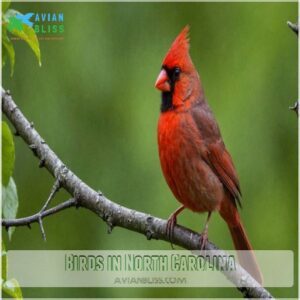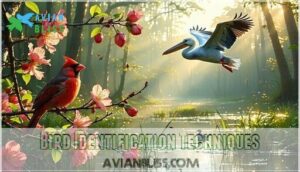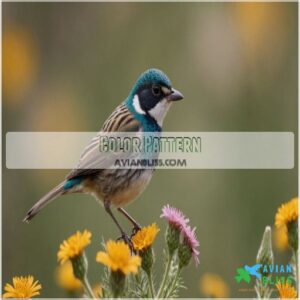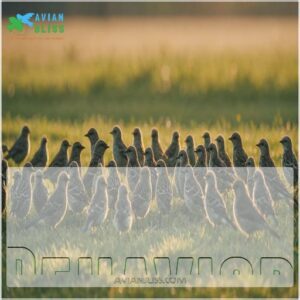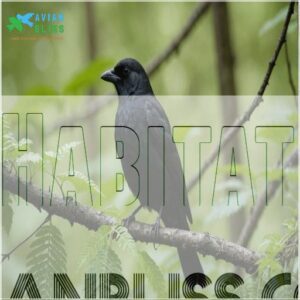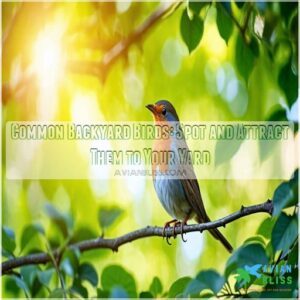This site is supported by our readers. We may earn a commission, at no cost to you, if you purchase through links.
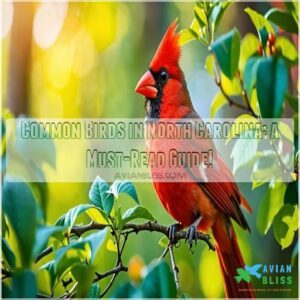
Common birds in North Carolina include the vibrant Northern Cardinal, the curious Carolina Wren, and the charming Tufted Titmouse.
Walking through the woods, you might also spot the industrious Carolina Chickadee or hear the American Crow’s caw—like nature’s alarm clock!
Birdwatching here is like having old friends greet you with a song.
Want to know their secret codes or how to spot them effortlessly?
Stick around; there’s more to these avian companions than meets the eye.
Table Of Contents
- Key Takeaways
- Birds in North Carolina
- Bird Identification Techniques
- Common Backyard Birds
- Frequently Asked Questions (FAQs)
- What are the most common backyard birds in North Carolina?
- What birds can you see in North Carolina?
- How many birds are in North Carolina?
- What birds live in North Carolina in winter?
- Are blackbirds common in North Carolina?
- What birds eat in North Carolina?
- What is the common bird in North Carolina?
- How do I identify a bird in my backyard?
- What is a gray bird with a white belly in NC?
- What is the big white bird in North Carolina?
- What are the best birdwatching spots in North Carolina?
- Which bird species migrate to North Carolina?
- How can I attract rare birds to my yard?
- What time of year is best for birding?
- Are there any birding festivals in North Carolina?
- Conclusion
Key Takeaways
- You’ll encounter vibrant birds like the Northern Cardinal, known for their physical characteristics, and the Northern Cardinal and Carolina Wren, which add color and song to North Carolina’s landscapes.
- Pay attention to bird identification techniques by observing size, shape, color patterns, behavior, and habitat.
- Birdwatching hotspots include the Outer Banks, Pisgah National Forest, and Lake Mattamuskeet.
- Attract birds to your yard by using native plants, varied feeders, and providing fresh water.
Birds in North Carolina
In North Carolina, you’re likely to spot a stunning array of birds, including the Northern Cardinal and the Carolina Wren.
These feathered friends add vibrant color and cheerful songs to the state’s diverse habitats.
Making each birdwatching experience memorable and amusing.
Northern Cardinal
Among the common birds in North Carolina, the Northern Cardinal stands out with its striking red plumage. Its cheerful song invites those curious about birdwatching.
It thrives in forest edges and backyards, offering plenty to explore. As the official state bird of North Carolina, it adds a splash of color to many residents’ gardens and feeders.
- Diet: Seeds
Carolina Wren
You’ll easily spot the Carolina Wren in North Carolina! Its song is a cheerful, bubbling melody.
These birds prefer dense shrubs and woodlands for nesting. They build their nests in cavities, often using natural materials.
Insects form a big part of their diet.
Wren conservation efforts focus on habitat protection.
Birdwatching in North Carolina often includes these delightful creatures. Their presence adds to the rich biodiversity of North Carolina birds.
Carolina Chickadee
Speaking of lively backyard birds, the Carolina Chickadee charms with its energetic calls and petite size.
Found across much of the southeast, this bird thrives in forests and suburban areas alike.
Its diet of insects and seeds keeps it active.
Look out for its bold, black-capped head and listen for its unmistakable song—a delightful presence among North Carolina birds.
Tufted Titmouse
Not far behind the energetic Chickadee, the Tufted Titmouse grabs attention with its cute crest and curious nature.
This bird species in North Carolina is a year-round visitor to your backyard, famously vocal with its ringing calls.
Its diet includes seeds, nuts, and insects.
Nesting in tree cavities, the Titmouse shows resourcefulness and a playful spirit that’s hard to ignore.
American Crow
American Crow, a ubiquitous bird species in North Carolina, offers fascinating insights.
Its iconic caw resonates, drawing attention to its adaptable nature.
For residents dealing with crow infestations, NC Crow Control methods can be particularly helpful.
Here’s what you should know:
- Diet: Omnivorous, enjoys crops and insects.
- **N
Bird Identification Techniques
When identifying birds in North Carolina, you’ll want to focus on key elements like size, shape, color patterns, behavior, and habitat.
It’s a bit like being a detective, but instead of solving crimes, you’re discovering the wonders of avian life!
Size and Shape
When identifying birds in North Carolina, notice their size and shape.
Think of bird silhouettes like a secret code—unique to each species.
Compare wingspan and tail length for hints, while body proportions tell their story.
Observe beak shapes for more clues.
This approach makes bird identification not just a skill, but a delightful backyard adventure.
Color Pattern
Spotting a bird often starts with its color pattern, a vibrant puzzle that nature paints. Picture Carolina Wrens with their camouflage patterns or the bold hues of Northern Cardinals. Look for these color clues:
- Bird color variations: Changes in shades.
- Seasonal plumage: Shifts with the seasons.
- Identifying markings: Unique spots or stripes.
- Color-based identification: Instantly recognizable shades.
Behavior
Observing bird behavior is key to identification.
Note their feeding behavior—do they flit to feeders or forage on the ground?
Consider nesting habits; some build elaborate nests, others use simpler structures.
Watch for social interactions; are they solitary or part of a flock?
Understanding these aspects, along with migration patterns and territoriality, will boost your bird watching skills.
You’ll become a backyard bird expert in no time!
Habitat
Have you ever thought about where birds hang their hats?
Habitat plays a key role in bird identification.
In North Carolina, you’ll find backyard birds adapting to various environments for food sources and shelter, and you can lure these birds to your backyard with the right bird feeders north carolina.
Seasonal changes bring shifts in habitats, so keep an eye
Common Backyard Birds
Right in your North Carolina backyard, you’ll find birds like Northern Cardinals and Carolina Chickadees flitting about, adding a splash of color and melody to your space.
They’re a surefire delight in any season.
You can attract them with a variety of bird feeders, especially those that are filled with seeds that are native to the region.
During the sultry summers, keep an eye out for Indigo Buntings and Ruby-throated Hummingbirds, both drawn to sweet feeders.
As winter approaches, welcome the melodic Song Sparrows and the lively Dark-eyed Juncos.
Attracting these common backyard birds is as simple as setting up a variety of bird feeders and offering fresh water.
By providing native plants, you’ll also give them a habitat to thrive in.
With a little patience and the right setup, your backyard will transform into a feather-filled paradise.
Frequently Asked Questions (FAQs)
What are the most common backyard birds in North Carolina?
Imagine your backyard bustling like a bird festival.
In North Carolina, common visitors include the Northern Cardinal, Carolina Chickadee, Carolina Wren, Tufted Titmouse, and American Crow, each bringing their charm and melody to your outdoor oasis.
What birds can you see in North Carolina?
North Carolina boasts diverse birdlife!
You’ll spot cardinals, wrens, chickadees, and blue jays frequently.
Depending on the season, you might also see hummingbirds, sparrows, or even migrating warblers.
Birdwatching’s a fun hobby!
How many birds are in North Carolina?
You might wonder how many bird species North Carolina hosts.
It’s a birder’s paradise with over 460 recorded species.
From coastal zones to mountainous regions, diverse habitats foster unique varieties, offering endless opportunities for birdwatchers.
What birds live in North Carolina in winter?
In winter, you can spot North Carolina’s frequent feathered friends like the White-throated Sparrow, Dark-eyed Junco, Yellow-rumped Warbler, Ruby-crowned Kinglet, and Song Sparrow.
These winter visitors bring charm to chilly backyard mornings.
Are blackbirds common in North Carolina?
Imagine this: you’re in a North Carolina backyard, hearing blackbirds’ quirky tunes.
While they’re present, they’re not as common as cardinals and chickadees.
Keep your eyes peeled, though—they often surprise with vibrant gatherings during migration.
What birds eat in North Carolina?
Birds in North Carolina enjoy a varied diet.
They munch on seeds, insects, fruits, and nuts.
Northern Cardinals love sunflower seeds, while American Crows often snack on insects and grains.
Each bird species has unique preferences.
What is the common bird in North Carolina?
Imagine a vibrant splash of red darting through the trees—the Northern Cardinal, North Carolina’s most common bird.
You’ll often spot this eye-catching, cheerful songbird year-round, gracing backyards and woodlands with its vivid presence.
How do I identify a bird in my backyard?
To identify a backyard bird, notice its size, shape, and colors.
Check its behaviors, like pecking or singing.
Observe the surroundings—woods or open fields matter.
With practice, you’ll spot familiar feathered friends!
What is a gray bird with a white belly in NC?
So, you’ve spotted a gray bird with a white belly in NC?
That’s exciting!
It could be a White-breasted Nuthatch.
They’re common, love trees, and have that distinctive coloring.
Check its size and beak shape for confirmation.
What is the big white bird in North Carolina?
In North Carolina, you’re likely spotting the Great Egret when you see a big white bird.
With its impressive wingspan, long neck, and elegant stance, this graceful bird is often seen around wetlands and waterways.
What are the best birdwatching spots in North Carolina?
When you’re ready to explore nature’s symphony, check out the Outer Banks, Pisgah National Forest, or Lake Mattamuskeet.
These spots offer a variety of habitats that are perfect for spotting both rare and common birds.
Which bird species migrate to North Carolina?
Many birds migrate to North Carolina, including the Indigo Bunting and Barn Swallow.
Birds bring vibrant life to the region throughout the seasons.
In winter, look for Dark-eyed Juncos and Yellow-rumped Warblers.
How can I attract rare birds to my yard?
You might believe rare birds won’t visit your yard, but try these tips:
plant native trees for shelter,
offer varied feeders and fresh water,
and create a brush pile for nesting.
Your yard could become their favorite hangout!
What time of year is best for birding?
Spring and fall are the prime seasons for birding, thanks to migration.
In spring, birds flaunt breeding plumage; fall brings diverse species.
Early mornings offer the best chance to spot a variety of active birds.
Are there any birding festivals in North Carolina?
Check out the Wings Over Water Wildlife Festival, or the Cape Fear Birding and Nature Festival, both held annually in North Carolina.
Engage with fellow bird lovers, enjoy guided walks, and discover diverse species in beautiful locales.
Conclusion
So, you’ve learned about some common birds in North Carolina—their looks, habitats, and behaviors.
Remember, birdwatching is a fun adventure!
Identifying these common birds in North Carolina takes practice, but you’ll soon become an expert.
You’ll start recognizing their songs, noticing their unique flight patterns, and appreciating their diverse habitats.
Next time you’re outside, keep your eyes peeled—you might just spot a Carolina Wren or a Northern Cardinal!
Happy birding!

